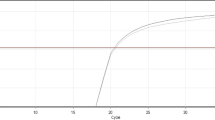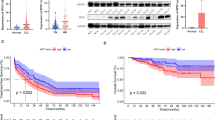Summary
Background
The Wnt pathway is aberrantly activated in chronic lymphocytic leukemia (CLL) and contributes to the antiapoptotic and mitogenic characteristics of CLL cells. Lymphoid enhancer-binding factor‑1 (LEF1) acts as a mediator and key transcription factor of the Wnt/β-catenin pathway. LEF1 helps to regulate important genes involved in tumor cell death mechanisms.
Objective
To analyze the expression levels of Wnt signaling pathway member (WNT3) and its key mediator LEF1 in Egyptian CLL patients and to detect the potential use of these genes as markers of CLL outcome.
Methods
We quantified the expression levels of Wnt3 and LEF1 in peripheral blood mononuclear cells of 30 untreated CLL and 19 healthy controls by qRT-PCR (quantitative real time polymerase chain reaction).
Results
Our study demonstrated significant upregulation of both Wnt3 and LEF1 in CLL (P < 0.0001). WNT3 and LEF1 were significantly decreased in CLL patients with ECOG performance 2 and 3 than those with 0 and 1 (p = 0.023 and 0.007, respectively). CLL patients with 17p deletion express significantly low LEF1 (p = 0.033). Low levels of WNT3 and LEF1 expression indicated a shorter overall survival (P = 0.007, 0.005, respectively). The predictive power of WNT3 and LEF1 expression showed good discrimination of CLL patients from controls (AUC >0.9).
Conclusion
Upregulation of WNT3 and LEF1 could be used as helpful and specific markers to distinguish our CLL patients. Low WNT3 and LEF1 expression is associated with shortened survival in CLL patients. These results indicate that WNT3 and LEF1 represent an attractive therapeutic target for future therapies in Egyptian CLL patients.




Similar content being viewed by others
References
Messmer BT, Messmer D, Allen SL, Kolitz JE, Kudalkar P, Cesar D, et al. In vivo measurements document the dynamic cellular kinetics of chronic lymphocytic leukemia B cells. J Clin Invest. 2005;115:755–64. https://doi.org/10.1172/JCI23409.
Hallek M, Information CME. Chronic lymphocytic leukemia: 2015 Update on diagnosis, risk stratification, and treatment. Am J Hematol. 2015;90:446–60. https://doi.org/10.1002/ajh.00046.
Jelinek DF, Tschumper RC, Stolovitzky GA, Iturria SJ, Tu Y, Lepre J, et al. Identification of a global gene expression signature of B‑chronic lymphocytic leukemia. Mol Cancer Res. 2003;1:346–61.
Rosenwald A, Alizadeh AA, Widhopf G, Simon R, Davis RE, Yu X, et al. Relation of gene expression phenotype to immunoglobulin mutation genotype in B cell chronic lymphocytic leukemia. J Exp Med. 2001;194:1639–47.
Memarian A, Hojjat-Farsangi M, Asgarian-Omran H, Younesi V, Jeddi-Tehrani M, Sharifian RA, et al. Variation in WNT genes expression in different subtypes of chronic lymphocytic leukemia. Leuk Lymphoma. 2009;50:2061–70. https://doi.org/10.3109/10428190903331082.
Wang L, Shalek AK, Lawrence M, Ding R, Gaublomme JT, Pochet N, et al. Somatic mutation as a mechanism of Wnt/beta-catenin pathway activation in CLL. Blood. 2014;124:1089–98. https://doi.org/10.1182/blood-2014-01-552067.
Zenz T, Mertens D, Kuppers R, Dohner H, Stilgenbauer S. From pathogenesis to treatment of chronic lymphocytic leukaemia. Nat Rev Cancer. 2010;10:37–50. https://doi.org/10.1038/nrc2764.
Gutierrez AJ, Tschumper RC, Wu X, Shanafelt TD, Eckel-Passow J, Huddleston PM 3rd, et al. LEF‑1 is a prosurvival factor in chronic lymphocytic leukemia and is expressed in the preleukemic state of monoclonal B‑cell lymphocytosis. Blood. 2010;116:2975–83. https://doi.org/10.1182/blood-2010-02-269878.
Poppova L, Janovska P, Plevova K, Radova L, Plesingerova H, Borsky M, et al. Decreased WNT3 expression in chronic lymphocytic leukaemia is a hallmark of disease progression and identifies patients with worse prognosis in the subgroup with mutated IGHV. Br J Haematol. 2016;175:851–9. https://doi.org/10.1111/bjh.14312.
MacDonald BT, Tamai K, He X. Wnt/beta-catenin signaling: components, mechanisms, and diseases. Dev Cell. 2009;17:9–26. https://doi.org/10.1016/j.devcel.2009.06.016.
Reya T, Clevers H. Wnt signalling in stem cells and cancer. Nature. 2005;434:843–50. https://doi.org/10.1038/nature03319.
Gandhirajan RK, Staib PA, Minke K, Gehrke I, Plickert G, Schlösser A, et al. Small molecule inhibitors of Wnt/beta-catenin/lef‑1 signaling induces apoptosis in chronic lymphocytic leukemia cells in vitro and in vivo. Neoplasia. 2010;12:326–35. https://doi.org/10.1593/neo.91972.
Menter T, Dirnhofer S, Tzankov A. LEF1: a highly speci fi c marker for the diagnosis of chronic lymphocytic B cell leukaemia/small lymphocytic B cell lymphoma. J Clin Pathol. 2015;68(6):473–8. https://doi.org/10.1136/jclinpath-2015-202862.
Wu W, Zhu H, Fu Y, Shen W, Miao K, Hong M, et al. High LEF1 expression predicts adverse prognosis in chronic lymphocytic leukemia and may be targeted by ethacrynic acid. Oncotarget. 2016;7:21631–43. https://doi.org/10.18632/oncotarget.7795.
Skokowa J, Welte K. LEF‑1 is a decisive transcription factor in neutrophil granulopoiesis. Ann N Y Acad Sci. 2007;1106:143–51. https://doi.org/10.1196/annals.1392.012.
Reya T, O’Riordan M, Okamura R, Devaney E, Willert K, Nusse R, et al. Wnt signaling regulates B lymphocyte proliferation through a LEF‑1 dependent mechanism. Immunity. 2000;13:15–24. https://doi.org/10.1016/s1074-7613(00)00004-2.
Metzeler KH, Heilmeier B, Edmaier KE, Rawat VPS, Dufour A, Dohner K, et al. High expression of lymphoid enhancer-binding factor‑1 (LEF1) is a novel favorable prognostic factor in cytogenetically normal acute myeloid leukemia. Blood. 2012;120:2118–26. https://doi.org/10.1182/blood-2012-02-411827.
Elbaiomy MA, Aref S, El Zaafarany M, Atwa S, Akl T, El-Beshbishi W, et al. Prognostic impact of lymphoid enhancer factor 1 expression and serum Galectin.3 in Egyptian AML patients. Adv Hematol. 2019;2019:2352919. https://doi.org/10.1155/2019/2352919.
Aly RM, Yousef AB. Prognostic significance of lymphoid enhancer-binding factor‑1 expression in egyptian adult B‑acute lymphocytic leukemia patients. Turk J Haematol. 2015;32:15–20. https://doi.org/10.4274/tjh.2013.0140.
Kuhnl A, Gokbuget N, Kaiser M, Schlee C, Stroux A, Burmeister T, et al. Overexpression of LEF1 predicts unfavorable outcome in adult patients with B‑precursor acute lymphoblastic leukemia. Blood. 2011;118:6362–7. https://doi.org/10.1182/blood-2011-04-350850.
Gutierrez A, Sanda T, Ma W, Zhang J, Grebliunaite R, Dahlberg S, et al. Inactivation of LEF1 in T‑cell acute lymphoblastic leukemia. Blood. 2010;115:2845–51. https://doi.org/10.1182/blood-2009-07-234377.
Erdfelder F, Hertweck M, Filipovich A, Uhrmacher S, Kreuzer KA. High lymphoid enhancer-binding factor expression is associated with disease progression and poor prognosis in chronic lymphocytic leukemia. Hematol Rep. 2010;2:24–7. https://doi.org/10.4081/hr.2010.e3.
Spaulding C, Reschly EJ, Zagort DE, Yashiro-Ohtani Y, Beverly LJ, Capobianco A, et al. Notch1 co-opts lymphoid enhancer factor 1 for survival of murine T‑cell lymphomas. Blood. 2007;110:2650–8. https://doi.org/10.1182/blood-2007-04-084202.
McCarthy BA, Yancopoulos S, Tipping M, Yan X‑J, Wang XP, Bennett F, et al. A seven-gene expression panel distinguishing clonal expansions of pre-leukemic and chronic lymphocytic leukemia B cells from normal B lymphocytes. Immunol Res. 2015;63:90–100. https://doi.org/10.1007/s12026-015-8688-3.
Lu D, Zhao Y, Tawatao R, Cottam HB, Sen M, Leoni LM, et al. Activation of the Wnt signaling pathway in chronic lymphocytic leukemia. Proc Natl Acad Sci U S A. 2004;101:3118–23. https://doi.org/10.1073/pnas.0308648100.
Lu D, Liu JX, Endo T, Zhou H, Yao S, Willert K, et al. Ethacrynic acid exhibits selective toxicity to chronic lymphocytic leukemia cells by inhibition of the Wnt/β-catenin pathway. PLoS One. 2009;4(12):e8294. https://doi.org/10.1371/journal.pone.0008294.
Thanendrarajan S, Kim Y, Schmidt-Wolf IGH. Understanding and targeting the Wnt/β-catenin signaling pathway in chronic leukemia. Leuk Res Treatment. 2011;2011:1–7. https://doi.org/10.4061/2011/329572.
Petrini M, Conte A, Caracciolo F, Sabbatini A, Grassi B, Ronca G. Reversing of chlorambucil resistance by ethacrynic acid in a B-CLL patient. Br J Haematol. 1993;85:409–10. https://doi.org/10.1111/j.1365-2141.1993.tb03187.x.
Lu D, Choi MY, Yu J, Castro JE, Kipps TJ, Carson DA. Salinomycin inhibits wnt signaling and selectively induces apoptosis in chronic lymphocytic leukemia cells. Proc Natl Acad Sci U S A. 2011;108:13253–7. https://doi.org/10.1073/pnas.1110431108.
Razavi R, Gehrke I, Gandhirajan RK, Poll-Wolbeck SJ, Hallek M, Kreuzer KA. Nitric oxide-donating acetylsalicylic acid induces apoptosis in chronic lymphocytic leukemia cells and shows strong antitumor efficacy in vivo. Clin Cancer Res. 2011;17:286–93. https://doi.org/10.1158/1078-0432.CCR-10-1030.
Author information
Authors and Affiliations
Contributions
Sameh Shamaa, Layla M. Saleh, Noha Eisa and Manal Atef designed the study. Layla M. Saleh performed experiments. Sameh Shamaa, Layla M. Saleh, Noha Eisa and Manal Atef analyzed the data and wrote the manuscript. Sameh Shamaa, Layla M. Saleh and Noha Eisa assisted in editing the manuscript.
Corresponding author
Ethics declarations
Conflict of interest
M. Atef, L.M. Saleh, N. Eisa, and S. Shamaa declare that they have no competing interests.
Additional information
Publisher’s Note
Springer Nature remains neutral with regard to jurisdictional claims in published maps and institutional affiliations.
Rights and permissions
About this article
Cite this article
Atef, M., Saleh, L.M., Eisa, N. et al. WNT3 and LEF1 as markers for diagnosis and survival prediction in chronic lymphocytic leukemia patients. memo 16, 268–274 (2023). https://doi.org/10.1007/s12254-020-00651-8
Received:
Accepted:
Published:
Issue Date:
DOI: https://doi.org/10.1007/s12254-020-00651-8




